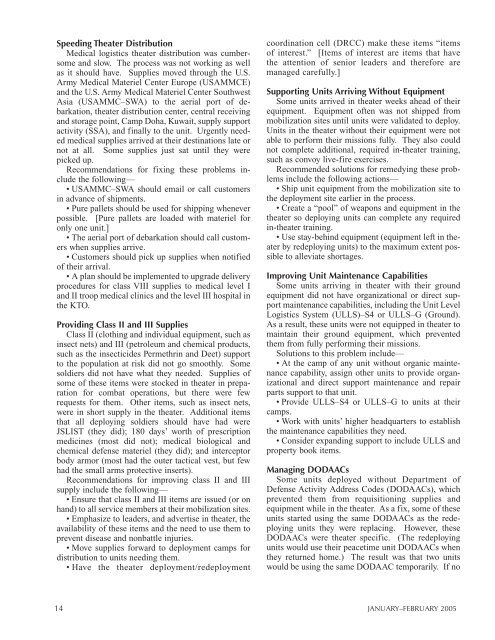Supporting the First Stryker Brigade in Iraq - Army Logistics ...
Supporting the First Stryker Brigade in Iraq - Army Logistics ...
Supporting the First Stryker Brigade in Iraq - Army Logistics ...
Create successful ePaper yourself
Turn your PDF publications into a flip-book with our unique Google optimized e-Paper software.
Speed<strong>in</strong>g Theater Distribution<br />
Medical logistics <strong>the</strong>ater distribution was cumbersome<br />
and slow. The process was not work<strong>in</strong>g as well<br />
as it should have. Supplies moved through <strong>the</strong> U.S.<br />
<strong>Army</strong> Medical Materiel Center Europe (USAMMCE)<br />
and <strong>the</strong> U.S. <strong>Army</strong> Medical Materiel Center Southwest<br />
Asia (USAMMC–SWA) to <strong>the</strong> aerial port of debarkation,<br />
<strong>the</strong>ater distribution center, central receiv<strong>in</strong>g<br />
and storage po<strong>in</strong>t, Camp Doha, Kuwait, supply support<br />
activity (SSA), and f<strong>in</strong>ally to <strong>the</strong> unit. Urgently needed<br />
medical supplies arrived at <strong>the</strong>ir dest<strong>in</strong>ations late or<br />
not at all. Some supplies just sat until <strong>the</strong>y were<br />
picked up.<br />
Recommendations for fix<strong>in</strong>g <strong>the</strong>se problems <strong>in</strong>clude<br />
<strong>the</strong> follow<strong>in</strong>g—<br />
• USAMMC–SWA should email or call customers<br />
<strong>in</strong> advance of shipments.<br />
• Pure pallets should be used for shipp<strong>in</strong>g whenever<br />
possible. [Pure pallets are loaded with materiel for<br />
only one unit.]<br />
• The aerial port of debarkation should call customers<br />
when supplies arrive.<br />
• Customers should pick up supplies when notified<br />
of <strong>the</strong>ir arrival.<br />
• A plan should be implemented to upgrade delivery<br />
procedures for class VIII supplies to medical level I<br />
and II troop medical cl<strong>in</strong>ics and <strong>the</strong> level III hospital <strong>in</strong><br />
<strong>the</strong> KTO.<br />
Provid<strong>in</strong>g Class II and III Supplies<br />
Class II (cloth<strong>in</strong>g and <strong>in</strong>dividual equipment, such as<br />
<strong>in</strong>sect nets) and III (petroleum and chemical products,<br />
such as <strong>the</strong> <strong>in</strong>secticides Permethr<strong>in</strong> and Deet) support<br />
to <strong>the</strong> population at risk did not go smoothly. Some<br />
soldiers did not have what <strong>the</strong>y needed. Supplies of<br />
some of <strong>the</strong>se items were stocked <strong>in</strong> <strong>the</strong>ater <strong>in</strong> preparation<br />
for combat operations, but <strong>the</strong>re were few<br />
requests for <strong>the</strong>m. O<strong>the</strong>r items, such as <strong>in</strong>sect nets,<br />
were <strong>in</strong> short supply <strong>in</strong> <strong>the</strong> <strong>the</strong>ater. Additional items<br />
that all deploy<strong>in</strong>g soldiers should have had were<br />
JSLIST (<strong>the</strong>y did); 180 days’ worth of prescription<br />
medic<strong>in</strong>es (most did not); medical biological and<br />
chemical defense materiel (<strong>the</strong>y did); and <strong>in</strong>terceptor<br />
body armor (most had <strong>the</strong> outer tactical vest, but few<br />
had <strong>the</strong> small arms protective <strong>in</strong>serts).<br />
Recommendations for improv<strong>in</strong>g class II and III<br />
supply <strong>in</strong>clude <strong>the</strong> follow<strong>in</strong>g—<br />
• Ensure that class II and III items are issued (or on<br />
hand) to all service members at <strong>the</strong>ir mobilization sites.<br />
• Emphasize to leaders, and advertise <strong>in</strong> <strong>the</strong>ater, <strong>the</strong><br />
availability of <strong>the</strong>se items and <strong>the</strong> need to use <strong>the</strong>m to<br />
prevent disease and nonbattle <strong>in</strong>juries.<br />
• Move supplies forward to deployment camps for<br />
distribution to units need<strong>in</strong>g <strong>the</strong>m.<br />
• Have <strong>the</strong> <strong>the</strong>ater deployment/redeployment<br />
14<br />
coord<strong>in</strong>ation cell (DRCC) make <strong>the</strong>se items “items<br />
of <strong>in</strong>terest.” [Items of <strong>in</strong>terest are items that have<br />
<strong>the</strong> attention of senior leaders and <strong>the</strong>refore are<br />
managed carefully.]<br />
<strong>Support<strong>in</strong>g</strong> Units Arriv<strong>in</strong>g Without Equipment<br />
Some units arrived <strong>in</strong> <strong>the</strong>ater weeks ahead of <strong>the</strong>ir<br />
equipment. Equipment often was not shipped from<br />
mobilization sites until units were validated to deploy.<br />
Units <strong>in</strong> <strong>the</strong> <strong>the</strong>ater without <strong>the</strong>ir equipment were not<br />
able to perform <strong>the</strong>ir missions fully. They also could<br />
not complete additional, required <strong>in</strong>-<strong>the</strong>ater tra<strong>in</strong><strong>in</strong>g,<br />
such as convoy live-fire exercises.<br />
Recommended solutions for remedy<strong>in</strong>g <strong>the</strong>se problems<br />
<strong>in</strong>clude <strong>the</strong> follow<strong>in</strong>g actions—<br />
• Ship unit equipment from <strong>the</strong> mobilization site to<br />
<strong>the</strong> deployment site earlier <strong>in</strong> <strong>the</strong> process.<br />
• Create a “pool” of weapons and equipment <strong>in</strong> <strong>the</strong><br />
<strong>the</strong>ater so deploy<strong>in</strong>g units can complete any required<br />
<strong>in</strong>-<strong>the</strong>ater tra<strong>in</strong><strong>in</strong>g.<br />
• Use stay-beh<strong>in</strong>d equipment (equipment left <strong>in</strong> <strong>the</strong>ater<br />
by redeploy<strong>in</strong>g units) to <strong>the</strong> maximum extent possible<br />
to alleviate shortages.<br />
Improv<strong>in</strong>g Unit Ma<strong>in</strong>tenance Capabilities<br />
Some units arriv<strong>in</strong>g <strong>in</strong> <strong>the</strong>ater with <strong>the</strong>ir ground<br />
equipment did not have organizational or direct support<br />
ma<strong>in</strong>tenance capabilities, <strong>in</strong>clud<strong>in</strong>g <strong>the</strong> Unit Level<br />
<strong>Logistics</strong> System (ULLS)–S4 or ULLS–G (Ground).<br />
As a result, <strong>the</strong>se units were not equipped <strong>in</strong> <strong>the</strong>ater to<br />
ma<strong>in</strong>ta<strong>in</strong> <strong>the</strong>ir ground equipment, which prevented<br />
<strong>the</strong>m from fully perform<strong>in</strong>g <strong>the</strong>ir missions.<br />
Solutions to this problem <strong>in</strong>clude—<br />
• At <strong>the</strong> camp of any unit without organic ma<strong>in</strong>tenance<br />
capability, assign o<strong>the</strong>r units to provide organizational<br />
and direct support ma<strong>in</strong>tenance and repair<br />
parts support to that unit.<br />
• Provide ULLS–S4 or ULLS–G to units at <strong>the</strong>ir<br />
camps.<br />
• Work with units’ higher headquarters to establish<br />
<strong>the</strong> ma<strong>in</strong>tenance capabilities <strong>the</strong>y need.<br />
• Consider expand<strong>in</strong>g support to <strong>in</strong>clude ULLS and<br />
property book items.<br />
Manag<strong>in</strong>g DODAACs<br />
Some units deployed without Department of<br />
Defense Activity Address Codes (DODAACs), which<br />
prevented <strong>the</strong>m from requisition<strong>in</strong>g supplies and<br />
equipment while <strong>in</strong> <strong>the</strong> <strong>the</strong>ater. As a fix, some of <strong>the</strong>se<br />
units started us<strong>in</strong>g <strong>the</strong> same DODAACs as <strong>the</strong> redeploy<strong>in</strong>g<br />
units <strong>the</strong>y were replac<strong>in</strong>g. However, <strong>the</strong>se<br />
DODAACs were <strong>the</strong>ater specific. (The redeploy<strong>in</strong>g<br />
units would use <strong>the</strong>ir peacetime unit DODAACs when<br />
<strong>the</strong>y returned home.) The result was that two units<br />
would be us<strong>in</strong>g <strong>the</strong> same DODAAC temporarily. If no<br />
JANUARY–FEBRUARY 2005







